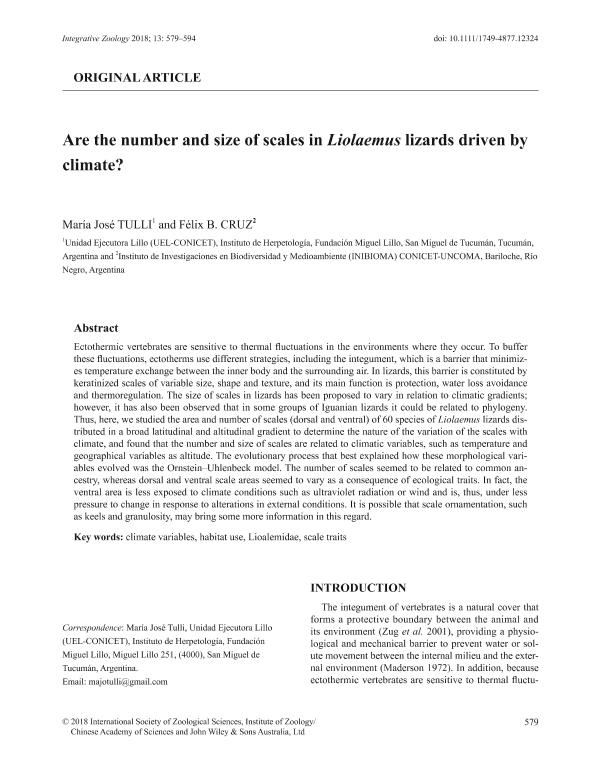Artículo
Are the number and size of scales in Liolaemus lizards driven by climate?
Fecha de publicación:
09/2018
Editorial:
Wiley-Blackwell
Revista:
Integrative Zoology
ISSN:
1749-4877
Idioma:
Inglés
Tipo de recurso:
Artículo publicado
Clasificación temática:
Resumen
Ectothermic vertebrates are sensitive to thermal fluctuations in the environments where they occur. To buffer these fluctuations, ectotherms use different strategies, including the integument, which is a barrier that minimizes temperature exchange between the inner body and the surrounding air. In lizards, this barrier is constituted by keratinized scales of variable size, shape and texture, and its main function is protection, water loss avoidance and thermoregulation. The size of scales in lizards has been proposed to vary in relation to climatic gradients; however, it has also been observed that in some groups of Iguanian lizards it could be related to phylogeny. Thus, here, we studied the area and number of scales (dorsal and ventral) of 60 species of Liolaemus lizards distributed in a broad latitudinal and altitudinal gradient to determine the nature of the variation of the scales with climate, and found that the number and size of scales are related to climatic variables, such as temperature and geographical variables as altitude. The evolutionary process that best explained how these morphological variables evolved was the Ornstein-Uhlenbeck model. The number of scales seemed to be related to common ancestry, whereas dorsal and ventral scale areas seemed to vary as a consequence of ecological traits. In fact, the ventral area is less exposed to climate conditions such as ultraviolet radiation or wind and is, thus, under less pressure to change in response to alterations in external conditions. It is possible that scale ornamentation, such as keels and granulosity, may bring some more information in this regard.
Palabras clave:
CLIMATE VARIABLES
,
HABITAT USE
,
LIOALEMIDAE
,
SCALE TRAITS
Archivos asociados
Licencia
Identificadores
Colecciones
Articulos(UEL)
Articulos de UNIDAD EJECUTORA LILLO
Articulos de UNIDAD EJECUTORA LILLO
Citación
Tulli, María José; Cruz, Felix Benjamin; Are the number and size of scales in Liolaemus lizards driven by climate?; Wiley-Blackwell; Integrative Zoology; 13; 5; 9-2018; 579-594
Compartir
Altmétricas




